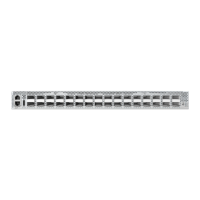C
HAPTER
15
| IP Configuration
Setting the Switch’s IP Address (IP Version 6)
– 582 –
◆ ICMPv6 – Internet Control Message Protocol for Version 6 addresses is
a network layer protocol that transmits message packets to report
errors in processing IPv6 packets. ICMP is therefore an integral part of
the Internet Protocol. ICMP messages may be used to report various
situations, such as when a datagram cannot reach its destination, when
the gateway does not have the buffering capacity to forward a
datagram, and when the gateway can direct the host to send traffic on
a shorter route. ICMP is also used by routers to feed back information
about more suitable routes (that is, the next hop router) to use for a
specific destination.
◆ UDP – User Datagram Protocol provides a datagram mode of packet
switched communications. It uses IP as the underlying transport
mechanism, providing access to IP-like services. UDP packets are
delivered just like IP packets – connection-less datagrams that may be
discarded before reaching their targets. UDP is useful when TCP would
be too complex, too slow, or just unnecessary.
PARAMETERS
These parameters are displayed:
Table 39: Show IPv6 Statistics - display description
Field Description
IPv6 Statistics
IPv6 Received
Total The total number of input datagrams received by the interface,
including those received in error.
Header Errors The number of input datagrams discarded due to errors in their
IPv6 headers, including version number mismatch, other format
errors, hop count exceeded, IPv6 options, etc.
Too Big Errors The number of input datagrams that could not be forwarded
because their size exceeded the link MTU of outgoing interface.
No Routes The number of input datagrams discarded because no route could
be found to transmit them to their destination.
Address Errors The number of input datagrams discarded because the IPv6
address in their IPv6 header's destination field was not a valid
address to be received at this entity. This count includes invalid
addresses (e.g., ::0) and unsupported addresses (e.g., addresses
with unallocated prefixes). For entities which are not IPv6 routers
and therefore do not forward datagrams, this counter includes
datagrams discarded because the destination address was not a
local address.
Unknown Protocols The number of locally-addressed datagrams received successfully
but discarded because of an unknown or unsupported protocol.
This counter is incremented at the interface to which these
datagrams were addressed which might not be necessarily the
input interface for some of the datagrams.
Truncated Packets The number of input datagrams discarded because datagram
frame didn't carry enough data.
Discards The number of input IPv6 datagrams for which no problems were
encountered to prevent their continued processing, but which
were discarded (e.g., for lack of buffer space). Note that this
counter does not include any datagrams discarded while awaiting
re-assembly.

